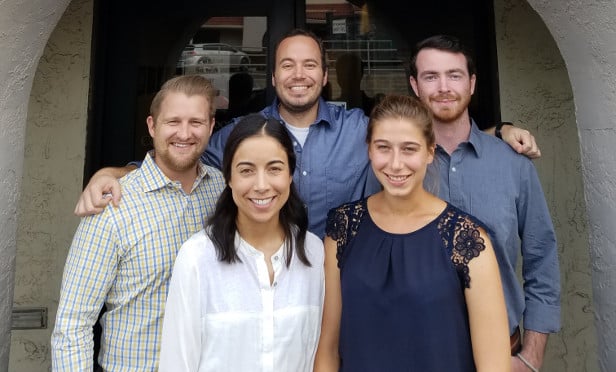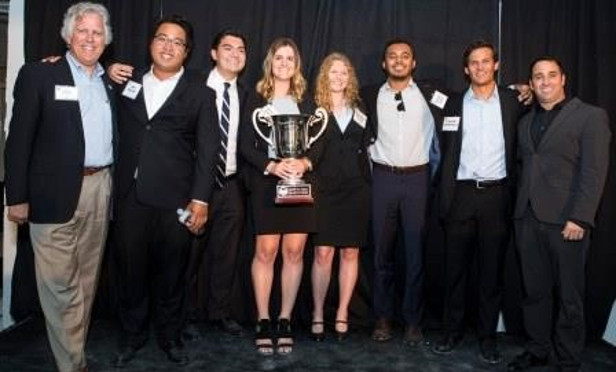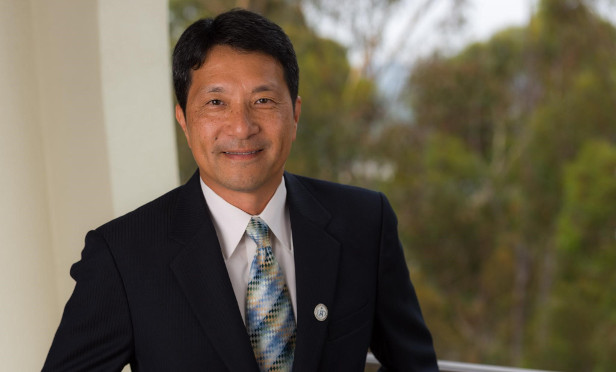 Kolbe (back row, center, with his teammates): “The way to differentiate yourselves is to really draw on everything you’ve learned during the program. Show you know a lot more of the scenario than is being asked of you.”
Kolbe (back row, center, with his teammates): “The way to differentiate yourselves is to really draw on everything you’ve learned during the program. Show you know a lot more of the scenario than is being asked of you.”
SAN DIEGO—Not wanting to break the streak, combined with a “go above and beyond” strategy, has helped lead the MSRE team at the Burnham-Moores Center for Real Estate at the University of San Diego to victory in six out of the eight times the ARGUS University Challenge has been held, a winning-team member and faculty advisor tell GlobeSt.com. The USD MSRE team recently took home first place in the 2017 ARGUS challenge, as it did in 2016, 2015, 2014, 2011 and 2009, placing second the other two years in 2012 and 2013).
In addition, a team of USD School of Business undergraduate real estate students recently took first place in the Seventh Annual NAIOP University Challenge. USD real estate seniors Danielle Priore ’17, Alexander Splinter ’17, Gwendolyn Walter ’17, Demarco Duran ’17, Forrest Greenwalt ’17 and Anh Nguyen ’17 competed against teams from the University of California San Diego and San Diego State University. The competition involved the highest and best use analysis of the Downtown county courthouse site, comprising 3.45 acres along three blocks of land, which was first built in the 1870s.
The University Challenge comprised three parts: a written report, a private question-and-answer session with a panel of nine senior-level commercial real estate executives who served as judges and a final presentation before 300 industry professionals at a NAIOP reception.
The USD team proposed a project titled “the Quartz” to fit in with the other gem-like building projects downtown. The project incorporated a creative residential component tailored specifically to millennials, featuring of 250 micro units at 250-350 square foot each. Along with the residential component, commercial and retail space also encompassed three blocks of prime downtown San Diego. The project also boasted numerous community benefits including: a San Diego Innovation Center Museum, a 5,000-square-foot dog park, an open-air concert venue and much more.
The USD undergraduate team addressed real estate-related topics, including financing, transit-oriented issues, sustainable development, traffic patterns, community impact, feasibility and investment returns.
 NAIOP University Challenge winners.
NAIOP University Challenge winners.
Those interested in being part of the USD MSRE winning team can contact [email protected] for more information or apply online at sandiego.edu/msre. More information can be found in the program’s new online brochure.
We spoke with Charles Tu, faculty advisor to the team, and Nick Kolbe, a member of this year’s winning team, about the challenge and why it has seen success so often.
GlobeSt.com: What has made for USD’s winning ARGUS University Challenge teams over the last six years?
Tu: In the first two challenges, in 2009 and 2011, those two teams really set the tone. After the first two years of repeat wins, the whole program became a point of pride, and students wanted to be part of this team and wanted to continue to defend the title; it has become a tradition. Initially, I didn’t even know what to expect. [ARGUS] is software most students coming into the program had never used before, but they learned how to use it and apply it to real estate. After the first two years, the USD teams continued to perform well, and it became much easier for me. Nowadays, prospective students contact us and will bring up our performance in the university challenge. They’ve heard about USD’s reputation, and a lot of students want to be a member of the team; they want to do well. The students are highly motivated, which makes it easier for me as an advisor to form the team and guide them. We prepare them with the finance and investment class, which has the ARGUS software integrated into the course, so they learn the fundamentals and how to use the software, and by spring they are well prepared for the competition.
Kolbe: The advisors gave us good advice, as did past winners. The way that Dr. Tu prepares us for the actual competition is that he basically tells us when we’re looking at this problem, “Don’t just take the case as they give it to you; look above and beyond, and add more value. The way to differentiate yourselves is to really draw on everything you’ve learned during the program. Show you know a lot more of the scenario than is being asked of you.”
When we were going through our report, after we had come up with the first three scenario results we would expect everybody to come up with, we would brainstorm and talk about what else we could do—tenant mixes, sustainable features and impact on our NOI and agglomeration (selection of tenant mix where you want to have the right tenants or demographics in that area, depending on the size of your strip center). The way they framed the case, there were three options; the property owner has three shopping centers and is trying to figure out whether to sell now, hold and not make improvements or take out a new loan and make some capital improvements. The owner is wondering, “If I improve the properties, is that going to make them more valuable?” It lowers cap rates and jumps rents. We tried to go above and beyond, so we started to do a little more analysis. What happens if you decide to sell early? We did a market-cycle analysis. We looked at doing an upREIT transaction for unrealized gains on property value, which would be a smart move. Little things like that gave our report more color and a higher level of understanding.
 sd-charles-tu
sd-charles-tu
Tu: “We never treated this competition as a software competition or a software exercise; it was more about strategic decision making, and that expectation really helped our students perform.”
GlobeSt.com: What do USD’s teams have over the competition?
Tu: One thing, especially this year—and with our report posted on the competition website, other schools will see this—our team did not treat this as a software exercise. Most schools think just need to use the software, put together a few correct models and summarize the results. We never treated this competition as a software competition or a software exercise; it was more about strategic decision making, and that expectation really helped our students perform. They definitely know how to take advantage of the functionalities in ARGUS, but it’s not just about taking information from a case, running the numbers and writing a report. You need to really consider what would be the benefits, the right decision for the case. That is one of our advantages, I think.
Kolbe: They’re going to see our report, but that’s kind of the way Dr. Tu framed it for us. You really need to go above and beyond. This is a master’s program, and I don’t know if all the others are, but we started talking about capital markets—what if she sells early, then what is she going to do with her money?
GlobeSt.com: What was particularly noteworthy about this year’s competition?
Tu: Every year, the case is different. A couple of years ago, the case was about green retrofit and sustainability; last year, it was about redevelopment and was much more complicated. This year, the case was simplified a little bit, but in terms of potential courses of action, there were so many options. Every year is unique and a new challenge. The title is fitting: it’s always a challenge, and that’s the fun part. Students have to think about what kind of challenge they’re facing and how to develop strategy to come up with a good solution.
Kolbe: It was definitely an interesting scenario. It mimicked what is going on in the retail industry, with struggling owners who are trying to figure out what they can do and are getting their lunch eaten by e-commerce and experiential retail. They need to think about what they need to do to keep tenants happy and provide a reason for people to keep coming back. The towns this was happening in had been through a recession period, but the bright light was that they were going to have boom—essentially, the Pokémon trend that happened last summer. It was a pretty good case to look at and try to apply what we talked about here to all kinds of retail centers. Retail really is a changing landscape. We learned a lot by digging in and doing research on the market and what has been successful.
GlobeSt.com: What else should our readers know about this year’s winning team?
Tu: From my perspective, every year when I’m forming the team, when talking to my colleagues, I try to find the right balance. It’s not just about financial analysis or ARGUS software, but about the team working on the project. The team was very balanced. There were two members with pretty extensive industry experience and two others almost no CRE experience. There was also one exchange student from Germany. The skill set was very diverse, and I think that’s one of our strengths. When forming a team on a real project, you can’t have a team where all the members have the same specialization. There are so many areas that can’t be covered that way. Our team covered all aspects, from understanding the CRE business to very analytical aspects to our great writer summarizing all the financial results to someone finalizing the report. We really make it like a professional document-company consultant would submit to clients. There’s a diversity of experience and knowledge.
Kolbe: I thought we had a really good team chemistry. Three guys on the team all have a good amount of experience behind us: I have 10 years, and there were others working for real estate companies as well. The girls were perfectionists; they are super smart, and they really carried us at the end with producing a high-quality-level report, can’t say enough how proud I am in how we came together. We spent a lot of weekends working on this, brainstorming, and there were arguments, but the girls really took it and put it into very good report.

















 Copyright © 2024 ALM Global, LLC. All Rights Reserved.
Copyright © 2024 ALM Global, LLC. All Rights Reserved.